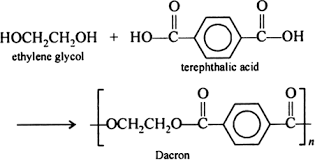Answer
393.6k+ views
Hint: The polymer used in this polymerisation condensation process is easily available and easy to do esterification with the polymer and in this process catalyst used is zinc acetate and antimony trioxide.
Complete step by step answer:
Terylene is a condensation polymer of ethylene glycol and Terephthalic acid
Terylene is the product of condensation polymerisation, In this polymerisation repetitive condensation takes place between two bi-functional monomers known as ethylene glycol and Terephthalic acid and produces high molecular mass condensation polymers. So it is prepared by the condensation polymerization of ethylene glycol and Terephthalic acid with removal of water. This reaction is performed at temperature 420-460 K in the presence of a catalyst such as zinc acetate and antimony trioxide.
Terylene is also called Dacron,Terylene is also called polyester.
Polymerisation reaction for the preparation of Terylene:

In the given 4 options, the only choice is Terephthalic acid it is because
Purified terephthalic acid available at lower cost and very easy and within less time direct esterification process can be done.
Properties of Terylene
Terylene is strong fibre and but this fibre loss its strength when it dipped in water
It is elastic in nature
Terylene can wash very easily and dries quickly.
It does not get damaged by acidic substances
Bleaches or dry cleaning agents cannot damage the terylene.
Use of Terylene-
Terylene used to prepare clothes like sarees, tapestry and dress material.
Note:
The Terylene is also called as Dacron and polyester and alcohol group in ethylene glycol and carboxylic acid group changes into ester group.
Complete step by step answer:
Terylene is a condensation polymer of ethylene glycol and Terephthalic acid
Terylene is the product of condensation polymerisation, In this polymerisation repetitive condensation takes place between two bi-functional monomers known as ethylene glycol and Terephthalic acid and produces high molecular mass condensation polymers. So it is prepared by the condensation polymerization of ethylene glycol and Terephthalic acid with removal of water. This reaction is performed at temperature 420-460 K in the presence of a catalyst such as zinc acetate and antimony trioxide.
Terylene is also called Dacron,Terylene is also called polyester.
Polymerisation reaction for the preparation of Terylene:

In the given 4 options, the only choice is Terephthalic acid it is because
Purified terephthalic acid available at lower cost and very easy and within less time direct esterification process can be done.
Properties of Terylene
Terylene is strong fibre and but this fibre loss its strength when it dipped in water
It is elastic in nature
Terylene can wash very easily and dries quickly.
It does not get damaged by acidic substances
Bleaches or dry cleaning agents cannot damage the terylene.
Use of Terylene-
Terylene used to prepare clothes like sarees, tapestry and dress material.
Note:
The Terylene is also called as Dacron and polyester and alcohol group in ethylene glycol and carboxylic acid group changes into ester group.
Recently Updated Pages
Basicity of sulphurous acid and sulphuric acid are

Three beakers labelled as A B and C each containing 25 mL of water were taken A small amount of NaOH anhydrous CuSO4 and NaCl were added to the beakers A B and C respectively It was observed that there was an increase in the temperature of the solutions contained in beakers A and B whereas in case of beaker C the temperature of the solution falls Which one of the following statements isarecorrect i In beakers A and B exothermic process has occurred ii In beakers A and B endothermic process has occurred iii In beaker C exothermic process has occurred iv In beaker C endothermic process has occurred

What is the stopping potential when the metal with class 12 physics JEE_Main

The momentum of a photon is 2 times 10 16gm cmsec Its class 12 physics JEE_Main

How do you arrange NH4 + BF3 H2O C2H2 in increasing class 11 chemistry CBSE

Is H mCT and q mCT the same thing If so which is more class 11 chemistry CBSE

Trending doubts
Difference between Prokaryotic cell and Eukaryotic class 11 biology CBSE

Fill the blanks with the suitable prepositions 1 The class 9 english CBSE

How fast is 60 miles per hour in kilometres per ho class 10 maths CBSE

What organs are located on the left side of your body class 11 biology CBSE

a Tabulate the differences in the characteristics of class 12 chemistry CBSE

How do you solve x2 11x + 28 0 using the quadratic class 10 maths CBSE

Change the following sentences into negative and interrogative class 10 english CBSE

Which are the major cities located on the river Ga class 10 social science CBSE

What is BLO What is the full form of BLO class 8 social science CBSE



